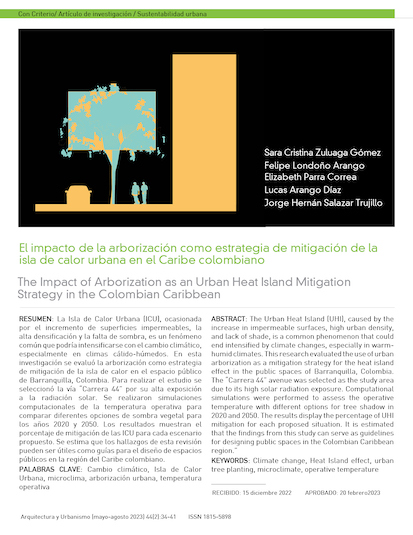The Impact of Arborization as an Urban Heat Island Mitigation Strategy in the Colombian Caribbean
Keywords:
Climate change, Heat Island effect, urban tree planting, microclimate, operative temperatureAbstract
The Urban Heat Island (UHI), caused by the increase in impermeable surfaces, high urban density, and lack of shade, is a common phenomenon that could end intensified by climate changes, especially in warm-humid climates. This research evaluated the use of urban arborization as a mitigation strategy for the heat island effect in the public spaces of Barranquilla, Colombia. The "Carrera 44" avenue was selected as the study area due to its high solar radiation exposure. Computational simulations were performed to assess the operative temperature with different options for tree shadow in 2020 and 2050. The results display the percentage of UHI mitigation for each proposed situation. It is estimated that the findings from this study can serve as guidelines for designing public spaces in the Colombian Caribbean region.
References
Naciones Unidas. Convención marco de las Naciones Unidas sobre el cambio climático. Naciones Unidas, 1992. Disponible en: https://unfccc.int/resource/docs/convkp/convsp.pdf
IPCC (Governmental Panel on Climate Change). IPCC Sixth Assessment Report. Summary for Policymakers. In: Climate Change 2021: The Physical Science Basis. Contribution of Working Group I to the Sixth Assessment Report. Disponible en: https://www.ipcc.ch/report/ar6/wg1/chapter/summary-for-policymakers/
Theran KR, Rodriguez L, Mouthon S, Manjarrés J. Microclima y Confort Térmico Urbano. Módulo Arquitectura CUC [Internet]. 2019 [consultado: 20 de Septiembre de 2022]; 23(1):[49-88 pp.]. Disponible en: https://doi.org/10.17981/mod.arq.cuc.23.1.2019.04
IPCC (Governmental Panel on Climate Change). Glosario. En: Planton S, (ed.). Cambio Climático 2013. Bases físicas. Contribución del Grupo de trabajo I al Quinto Informe de Evaluación del Grupo Intergubernamental de Expertos sobre el Cambio Climático. Cambridge University; 2013. Disponible en: https://www.ipcc.ch/site/assets/uploads/2018/08/WGI_AR5_glossary_ES.pdf
Alchapar NL, Correa EN, Cantón MA. Índice de reflectancia solar de revestimientos verticales: potencial para la mitigación de la isla de calor urbana. Ambiente Construído [Internet]. 2012 [consultado: 07 de Abril de 2021]; 12(3):[107-23 pp.]. Disponible en: http://hdl.handle.net/11336/78929
Corrales L, Brenes C. Islas de calor, impactos y respuestas: El caso del cantón de Curridabat. 2019 [consultado: 26 de Marzo de 2021]. Disponible en:
Flórez L. Simulación de diferentes escenarios de cobertura urbana y vegetal en el balance de energía superficial del Valle de Aburrá [tesis de maestría]. Bogotá: Universidad Nacional de Colombia; 2016. https://repositorio.unal.edu.co/handle/unal/59835
Ballinas MdJ. Mitigación de la isla de calor urbana: estudio de caso de la zona metropolitana de la ciudad de México [tesis de maestría]. México: Universidad Nacional Autónoma de México; 2011. Disponible en: https://repositorio.unam.mx/contenidos/65901
Sarricolea P, Martín J. El estudio de la Isla de Calor Urbana de Superficie del Área Metropolitana de Santiago de Chile con imágenes Terra-MODIS y Análisis de Componentes Principales. Revista de Geografía Norte Grande [Internet]. 2014 [consultado: 26 de Marzo de 2021]; 57:[123-41 pp.]. Disponible en: https://dialnet.unirioja.es/servlet/articulo?codigo=5784457

Downloads
Published
How to Cite
Issue
Section
License
Copyright (c) 2023 Revista científica de Arquitectura y Urbanismo

This work is licensed under a Creative Commons Attribution-NonCommercial-NoDerivatives 4.0 International License.
a. The authors retain the copyright and guarantee the magazine the right to be the first publication of the work as well as a Creative Commons Attribution License that allows others to share the work with an acknowledgment of the authorship of the work and the initial publication in this magazine.
b. Authors may separately establish additional agreements for the non-exclusive distribution of the version of the work published in the journal (for example, place it in an institutional repository or publish it in a book), with an acknowledgment of its initial publication in this journal.
c. Authors are allowed and encouraged to disseminate their work electronically (for example, in institutional repositories or on their own website) before and during the submission process, as it can lead to productive exchanges, as well as a more early and major published papers (See The Effect of Open Access, in English).

